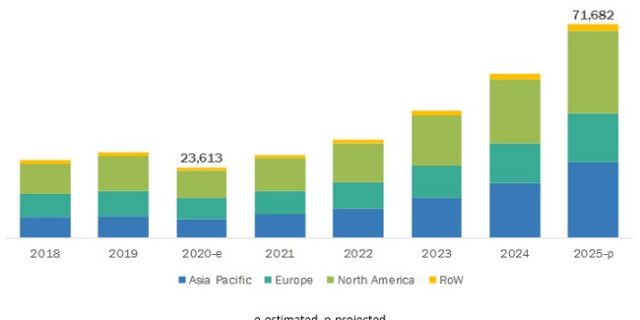
The report “Semi-Autonomous & Autonomous Bus Market by Level of Automation (Level 1, Level 2 & 3, Level 4, and Level 5), Propulsion (Diesel, Electric, and Hybrid), Application, ADAS Features, Sensor, and Region – Global Forecast to 2030″, size is projected to grow from 23,613 units in 2020 to reach 71,682 units by 2025, at a CAGR of 24.9%. On the other hand, the global autonomous bus market size is projected to grow from USD 791 million in 2024 to reach USD 2,773 million by 2030, at a CAGR of 23.2%.
The growth of the semi-autonomous bus market can be attributed to the increasing road accidents, the need for efficient bus operations and demand for ADAS features in the buses. Government bodies across the world have started regulating the safety standards in buses to reduce fatalities in road crashes. The increasing need for passenger and pedestrian safety, efficient public transport, reduction in CO2 emission, and advanced features have compelled OEMs to design and develop semi-autonomous and autonomous public transport solutions. Countries such as the US, Canada, China, Japan, UK, and Germany have already permitted the testing and trials of such innovative bus technologies.
Download PDF Brochure @ https://www.marketsandmarkets.com/pdfdownloadNew.asp?id=87328844
Factors such as shortage of drivers and increasing research and development in technologies such as V2X, 5G, connected buses, and ADAS will drive the market for autonomous buses in the forecast. The pandemic COVID-19 might affect the overall bus industry, as people will avoid using crowded public transport options for some time, resulting in the declined demand for buses.
North America is expected to lead the global market in the initial period of forecast
The North American region is projected to account for the largest share of the global semi-autonomous bus market during the forecast period. It is home to OEMs, such as New Flyer, Gillig, Novabus, Bluebird, Thomas Built Buses, and Proterra, that are offering advanced buses in the region. The region is dominated by modern buses having ADAS features as standard or optional. OEMs in the country have been providing many semi-autonomous driving features such as AEB, BSD, and ACC. Also, the region is home to many technology companies that are exploring the autonomous driving technology with testing and trials across the region.
Request Free Sample Report @ https://www.marketsandmarkets.com/requestsampleNew.asp?id=87328844
The shuttle segment is expected to be the largest market during the forecast
The shuttle segment is expected to dominate the autonomous bus market, as these are already commercialized. Many companies such as Navya, EasyMile, and Local Motors have developed self-driving shuttles. Successful pilot programs of autonomous shuttles across the world are indicating that shuttles could be a practical solution to the gaps in traditional public transport. For instance, EasyMile, a French autonomous shuttle provider, claims to have deployed the most number of such shuttles globally than any other company. Also, Navya, 2getthere, Local Motors, and Sensible4 are some of the companies that have developed, tested, and are offering autonomous shuttles. On the other hand, commercialization of intercity or intracity buses would take time due to challenges such as highway operation, long-distance, city traffic, lack of infrastructure (intracity coaches might require separate lane in the city and highway conditions), and government regulations.
Asia Pacific is expected to be the fastest-growing market during the forecast period
The Asia Pacific region comprises countries, such as China, Japan, and South Korea, which have a technologically advanced automotive industry. The Chinese bus company, King Long, developed a self-driving shuttle with the autonomous platform by Baidu and started first-ever volume production of these shuttles in June 2018. As China, Japan, and South Korea are capable of adopting such technology and produce on mass-level, the region will have a significant market share in the autonomous bus market. Apart from these testing and trials, the area is heavily dependent on buses as the public transport medium. Thus, recent developments in autonomous technologies and quick adoption of the technology would help the Asia Pacific market to grow rapidly.
Key Players:
The global semi-autonomous bus market is dominated by major players such as Continental (Germany) Bosch (Germany), Aptiv (UK), AB Volvo (Sweden), and Denso (Japan).
Critical Aspects:
- Governments are focusing on regulations related to safety standards in commercial vehicles. How will this transform the overall semi-autonomous bus market?
- How will fast-paced developments in self-driving technologies change the dynamics of this market?
- The industry is focusing on different sensors and software systems. Which are the leading companies working on it, and what organic and inorganic strategies have been adopted by them?
- The shuttle segment is expected to have a significant market during the forecast. How will this transform the overall autonomous bus market?
- Analysis of competitors, including major players in this market and ecosystem. The major players are Continental (Germany) Bosch (Germany), Aptiv (UK), AB Volvo (Sweden), and Denso (Japan).
To speak to our analyst for a discussion on the above findings, click Speak to Analyst
